New Boston Historical Society
New Boston, New Hampshire
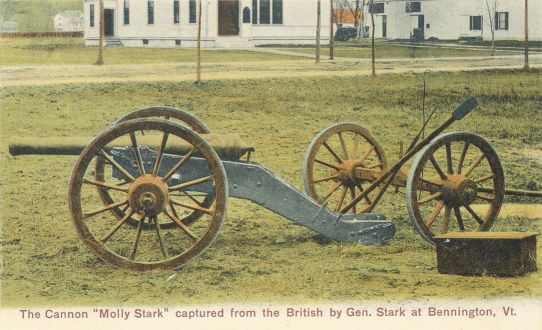
The "Molly Stark" Cannon
The Molly Stark cannon is New Hampshire's most famous artillery piece. Cast in 1743, the gun is fired three times each 4th of July by the New Boston Artillery Company. We believe that the Molly Stark is the oldest cannon anywhere that is still in use.The cannon's history is complicated, so we've used tiny flags to indicate which nation possessed the cannon at any point in time. Click on the links for more detail about the three wars in which the Molly Stark served, according to legend.
1743 - The cannon is cast in Paris, France and shipped to New France (Canada).

1759 - French & Indian War: British and colonial soldiers led by General Wolfe defeat French and Canadian defenders in the Battle of the Plains of Abraham outside Quebec City. The cannon is captured by the British.

1777 - Revolutionary War: General John Stark's New Hampshire Militia defeat Hessian soldiers at the Battle of Bennington and capture four cannon.

1812 - War of 1812: American soldiers use the cannon to defend Fort Detroit (Michigan) but the British capture the town and the cannon.

1813 - Americans recapture the cannon from the British at the Battle of Fort George (Ontario).

1820? - Sometime after the War of 1812 and before his death in 1822, General Stark gives the cannon to the New Hampshire Militia. It ends up in New Boston.
1861 - Civil War: When the U.S. Government requisitions all old guns to be melted down to cast new weapons, the cannon cannot be found.
1938 - The New Boston Artillery Company is reorganized to be the official custodian of the Molly Stark cannon.
1993 - The 250-year-old cannon receives its new gun carriage, built in New Boston as an exact replica of its 1812 carriage.

The 1743 Molly Stark Cannon is fired three times on July 4. This video shows the second firing in 2011.
After the cannon has been loaded and primed, it is fired by touching a "slow match" to the primer. In the video above, the "lintstock" which holds the slow match at the end of a long pole is historically accurate.
The cigarette lighter which is used to relight the slow match is not historically accurate!
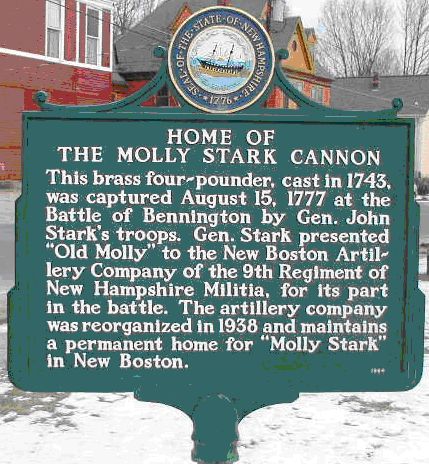
The inscription on the cannon has the correct date for the battle: August 16, 1777.
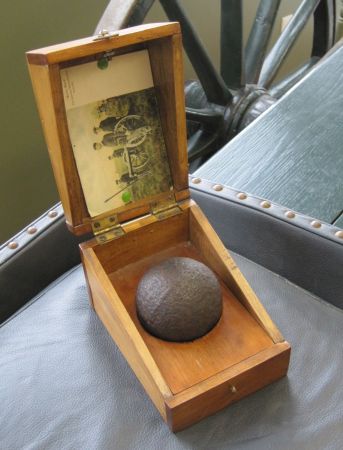
A four-pound cannon ball was found in a field at the Four-Way Farm in New Boston. Its age is unknown but it fits the Molly Stark cannon.
The Mostly True History of a Cannon
The Molly Stark Cannon saw action in three wars: the French and Indian War, the Revolutionary War, and the War of 1812. The history below will focus on four battles in which the Molly Stark is believed to have served: the Battles of Quebec (1759), Bennington (1777), Fort Detroit (1812) and Fort George (1813).1743 - A Cannon is Cast
The cannon was cast in Paris, France in 1743 for a trading company called the Compagnie des Indes. In the 17th and 18th centuries it was common for private companies to be established in Europe to trade with the East Indies (which include India), China, and the Americas. An early example is the East India Company which was chartered in London in 1600. A French competitor, formed in the early 1700s, was the Compagnie des Indes, which means the "Company of the Indies". The Compagnie traded in Canadian beaver furs, tobacco and other goods.
The cannon, which was not yet named the Molly Stark, has the words "Fait A Paris 1743" (Made in Paris 1743) cast into its base. It also bears the coat of arms of the Compagnie des Indes:
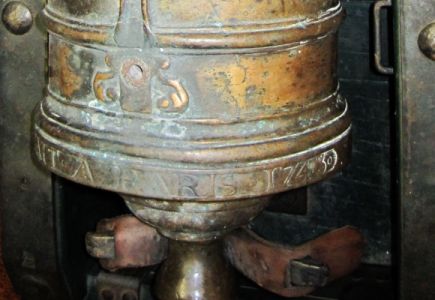
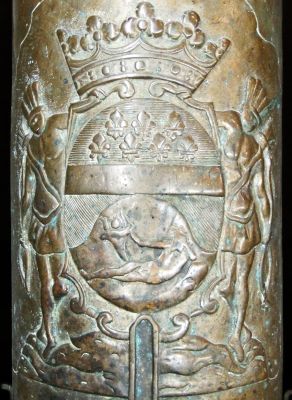

Go to [Top of Page] [French&Indian War] [Revolutionary War] [War of 1812]
The French and Indian War
1759 - Our cannon is captured by the British from the French in the Battle of Quebec.
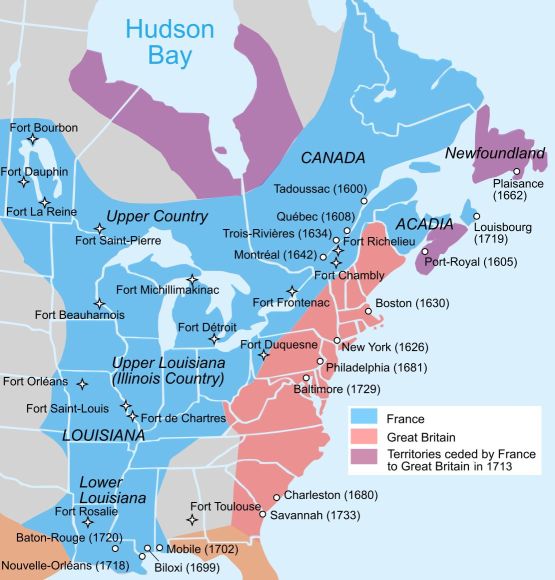
Map of North America c.1750
What about Native Americans? In 1750 there were about 250,000 North American Indians living east of the Mississippi. The native tribes were dominated by the Iroquois, a league of six nations who formed and dissolved alliances with the British or French with expediency.
The French and Indian War was fought between Great Britain and France between 1754 and 1763. The first few years saw military success for the French and their Indian allies. British defeats in North America and the Seven Years' War being fought in Europe at the same time led to a change of government in London. The new Prime Minister, William Pitt, strengthened the British Army and Navy in both continents which led to a series of British victories.
By the summer of 1759, British General James Wolfe was laying siege to Quebec City, defended by the French Marquis de Montcalm. After three months of siege, the British army was weakened by illness and low morale, so in September a frustrated Wolfe gambled on a daring surprise attack. He sent 5,000 men upriver on a moon-lit night to climb up steep slopes onto the Plains of Abraham outside the walls of Quebec City.
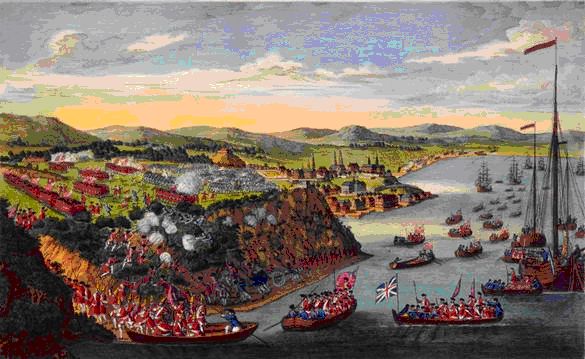
Battle of Quebec on the Plains of Abraham 1759
Results of French & Indian War:
* France loses most of its North American territory.
* The Americans fighting alongside the British learn that the British army is not invincible.
* The British government incurs so much debt fighting the war that it decides to increase taxes on its American colonies. Will this lead to a Tea Party?
Go to [Top of Page] [French&Indian War] [Revolutionary War] [War of 1812]
The Revolutionary War (American War of Independence)
1777 - Our cannon is captured by General John Stark from the British in the Battle of Bennington.
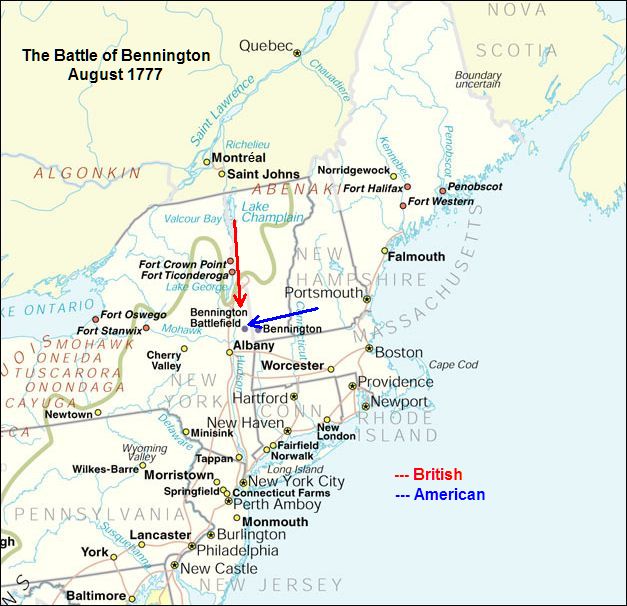
British and American routes to Bennington
When he encountered the Hessians, Stark reputedly told his militia men "There are your enemies, the Red Coats and the Tories. They are ours, or this night Molly Stark sleeps a widow!" (Note: the General's wife, Molly Page Stark, grew up in the Dunbarton, New Hampshire house which still stands on Route 13 by Page's Corner.)
Colonel Baum was inexperienced, hampered by his inability to speak English, and outnumbered. He requested reinforcements, and Burgoyne sent another 600 Hessian troops led by Colonel Heinrich von Breymann. However, von Breymann disliked Baum so he marched his men as slowly as possible and arrived after Baum and his troops had surrendered. After more fighting, von Breymann retreated, leaving behind all of his artillery pieces.
American casualties were 30 killed and 40 wounded. British losses were 200 killed and 700 captured. It was a great American victory.
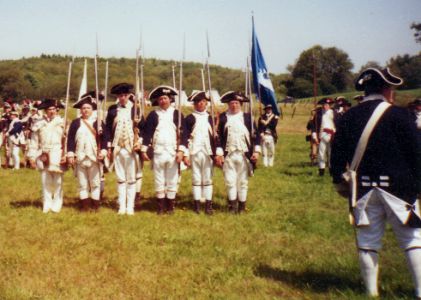
A rare color photograph from 1777 ?
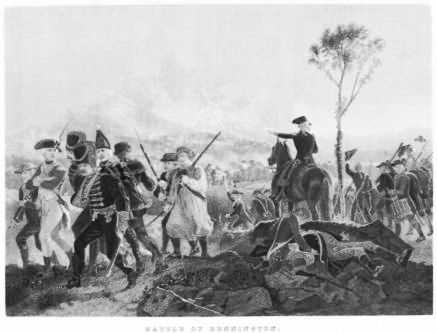
Hessian prisoners are led from the battlefield
The British army's defeat at the Battle of Bennington was a turning point in the War of Independence, as it led to the American victory in Saratoga and the end of Burgoyne's campaign. However we cannot be certain that the Molly Stark cannon actually was present at this pivotal battle. Some historians believe that the Hessians brought two 3-pounder and two 6-pounder cannon to the battle, and the Molly Stark is a 4-pounder*. Nevertheless the inscription still clearly visible on the top of the gun barrel reads: "Molly Stark - Taken at the Battle of Bennington, August 16th 1777. Presented to the New Boston Artillery Company 9th Regt N.H. Militia by Gen. John Stark". Newspaper articles from the late 1800s refer to "records" of the cannon's history that we do not possess today.
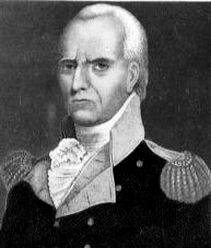
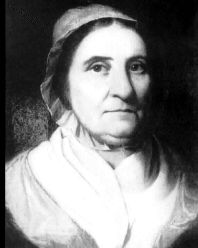
General John Stark and his wife Molly Stark, after 1800
Go to [Top of Page] [French&Indian War] [Revolutionary War] [War of 1812]
The War of 1812
1812 - Our cannon is captured by the British from the Americans in the Battle of Fort Detroit.
1813 - Our cannon is recaptured by the Americans in the Battle of Fort George.
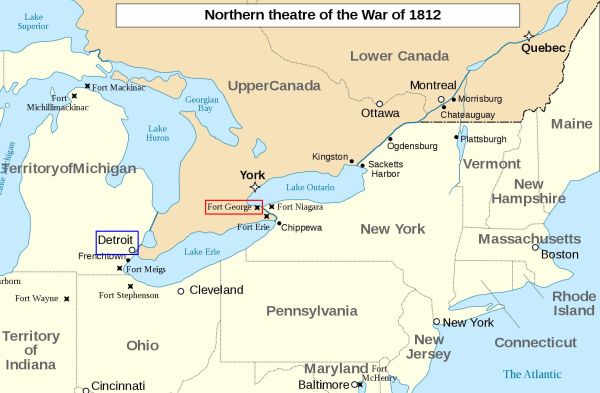
Map of Upper Canada ("up river" from Lower Canada) 1812
Early in the War of 1812, 700 British soldiers and 600 of their native allies laid siege to Fort Detroit, which was defended by Colonel William Hull and 2,200 American soldiers and militiamen.
British General Isaac Brock and the Shawnee leader Tecumseh tricked the Americans into believing that they were a much larger army. For example, the Americans watched as the distant British troops lined up for dinner. Each British soldier received his plateful of beans, carried it out of sight to dump the beans into a hidden pot, then rejoined the conspicuous line of men waiting to be fed.
The American general became convinced that he was opposed by thousands of British regulars. Listening to the Indian war cries, he feared for the safety of the women and children in the fort, including his daughter and grandchild. Against the advice of his subordinates, Hull surrendered Fort Detroit to the British. Military stores captured by the British included 30 cannon, 300 rifles and 2,500 muskets.
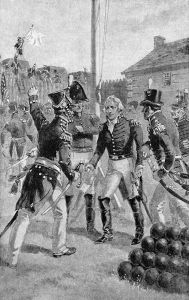
General Hull surrenders Fort Detroit to the British
The Battle of Fort George is notable for two facts:
1. The Americans launched an amphibious assault requiring cooperation between the U.S. Army and the U.S. Navy, which provided a corvette and a brig (small warships) and twelve gunboats.
2. The much smaller British defense included a black militia company of free negroes and indentured negro servants. Captain Runchey's Company of Coloured Men defended Upper Canada for fear that if the American invasion was successful, free blacks and escaped slaves would be sent into slavery in America.
After a brief battle, British General John Vincent ordered his troops to retreat. He also ordered his five field guns to be spiked and powder magazines to be blown up. His men had to retreat too hastily to perform these tasks successfully. This was fortunate for the British women and children Vincent left behind, who would have been blown up with the fort.
It is interesting to note that the American General Hull, who was concerned for the welfare of women and children in his charge, was court-martialed for surrendering Detroit. The less chivalrous British General Vincent had a long, successful military career after the Battle of Fort George, and died in 1848, never having married.
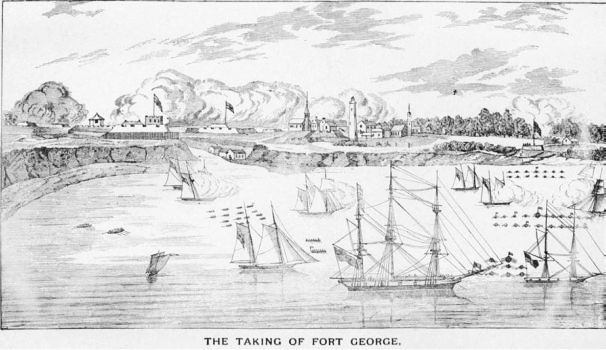
American landing at Fort George
When the War of 1812 ended in 1815, the Molly Stark cannon was over seventy years old and finally was retired from active duty. At some point during the war, the Molly had become separated from its mate. There was another 4-pounder cast in 1743 for the Compagnie des Indes, and for many years it was thought to have been lost at sea. Then in the 1960s, Dr. Robert Chaffee of Lyme, New Hampshire visited the Royal Artillery Museum at Woolwich near London, England. There he discovered a cannon which exactly matches the Molly Stark and is likely its long-lost mate.
By this time the Molly Stark had been given by the retired General Stark to the New Hampshire militia, and for the past 70-80 years the New Boston Artillery Company has been the caretaker of this historic cannon.
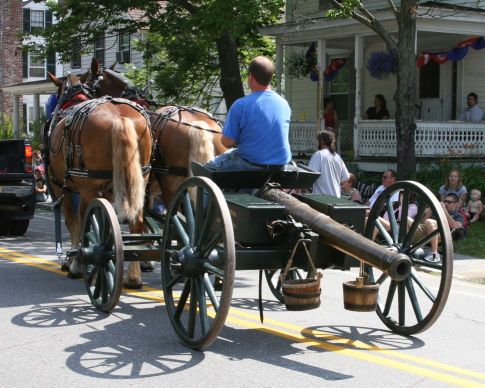
Molly Stark cannon in the 4th of July parade
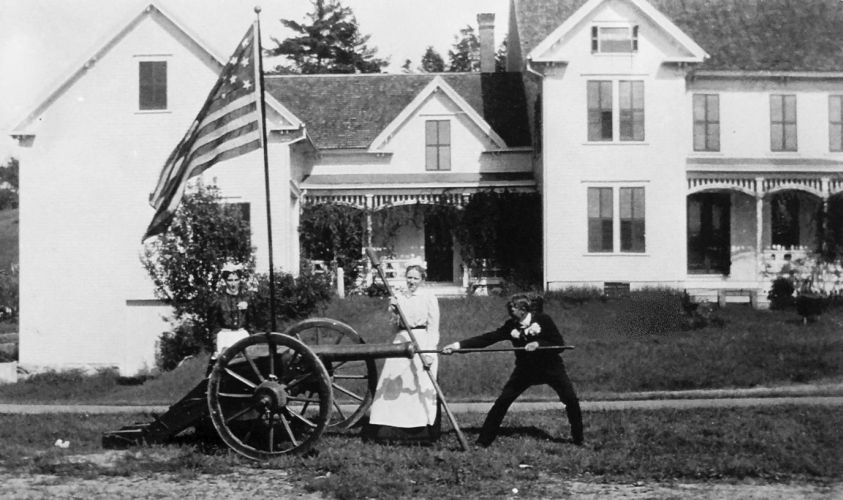
We don't know the names of the well-dressed gun crew loading the Molly Stark cannon at Farley's house next to the Town Hall.
Click here for a printable PDF of this "History Of The Molly Stark Cannon."
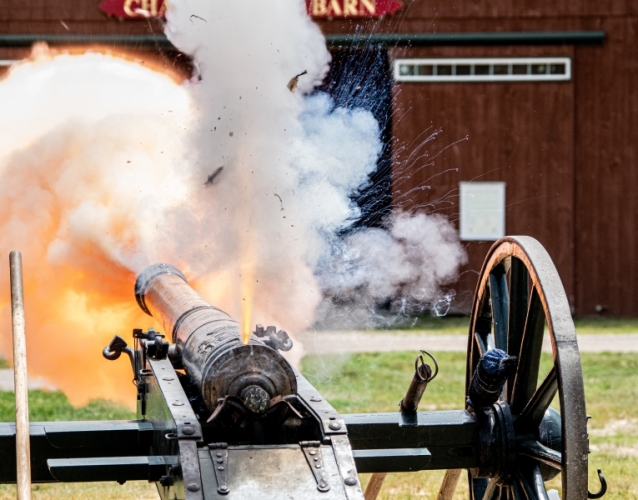
Molly Stark Cannon — July 4, 2019
For more information about this photo by John Poltrack,
see Photography in New Boston - Part 2.
